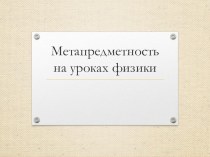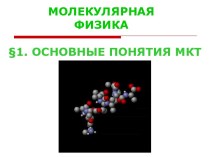- Главная
- Разное
- Бизнес и предпринимательство
- Образование
- Развлечения
- Государство
- Спорт
- Графика
- Культурология
- Еда и кулинария
- Лингвистика
- Религиоведение
- Черчение
- Физкультура
- ИЗО
- Психология
- Социология
- Английский язык
- Астрономия
- Алгебра
- Биология
- География
- Геометрия
- Детские презентации
- Информатика
- История
- Литература
- Маркетинг
- Математика
- Медицина
- Менеджмент
- Музыка
- МХК
- Немецкий язык
- ОБЖ
- Обществознание
- Окружающий мир
- Педагогика
- Русский язык
- Технология
- Физика
- Философия
- Химия
- Шаблоны, картинки для презентаций
- Экология
- Экономика
- Юриспруденция
Что такое findslide.org?
FindSlide.org - это сайт презентаций, докладов, шаблонов в формате PowerPoint.
Обратная связь
Email: Нажмите что бы посмотреть
Презентация на тему Quick Quiz
Содержание
- 2. Course of lectures «Contemporary Physics: Part1»Lecture №3Dynamics
- 3. Previously we described motion in terms of
- 4. The Concept of Forcecontact forcesfield forces
- 5. The Concept of ForceThe only known fundamental
- 6. The Concept of Force
- 7. If an object does not interact with
- 8. Such a reference frame is called an
- 9. When no force acts on an object,
- 10. MassMass is that property of an object
- 11. To describe mass quantitatively, we begin by
- 12. Mass is an inherent property of an
- 13. Mass should not be confused with weight.
- 14. Newton’s first law explains what happens to
- 15. Imagine performing an experiment in which you
- 16. The acceleration of an object also depends
- 17. According to this observation, we conclude that
- 18. Thus, we can relate mass, acceleration, and
- 19. The SI unit of force is the
- 20. (2.4)The Gravitational Force and Weight
- 21. The Gravitational Force and Weight
- 22. If you press against a corner of
- 23. Forces always occur in pairs, or that
- 24. Newton’s Third Law
- 25. Newton’s Third LawWhen we apply Newton’s laws
- 26. Newton’s Third LawObjects in EquilibriumIf the acceleration
- 27. Newton’s Third LawObjects Experiencing a Net Forceconstant
- 28. Actions of bodies to each other, making
- 29. Except elastic forces at the direct contact
- 30. The force that counteracts F and keeps
- 31. The magnitude of the force of static
- 32. We call the friction force for an
- 33. The magnitude of the force of kinetic
- 34. A particle moving with uniform speed v
- 35. Figure 2. Overhead view of a ball
- 36. If a particle moves with varying speed
- 37. Nonuniform Circular MotionA small sphere of mass
- 38. Motion in Accelerated Frames Figure 3. (a)
- 39. Motion in Accelerated FramesFigure 4.
- 40. Скачать презентацию
- 41. Похожие презентации







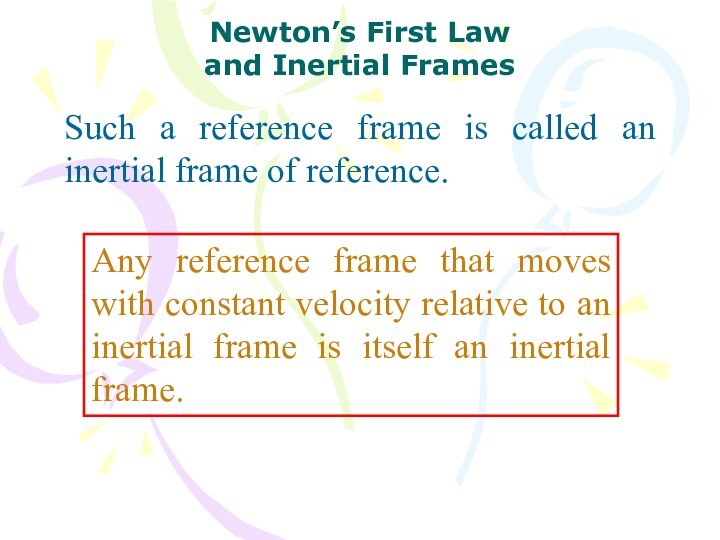



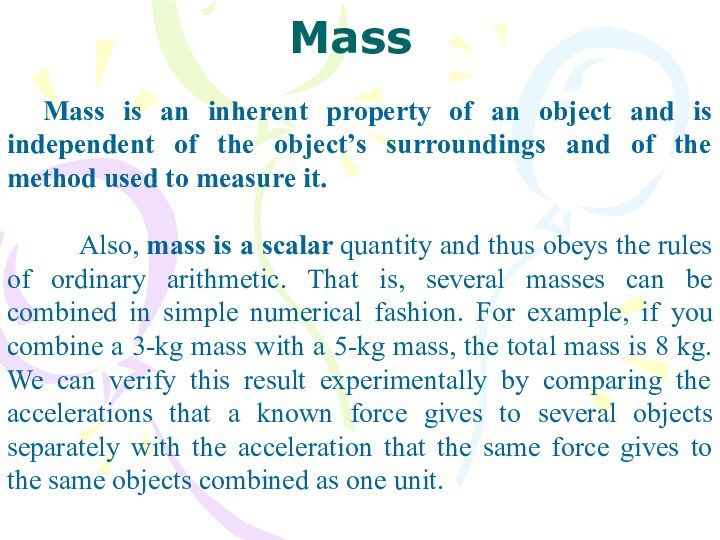







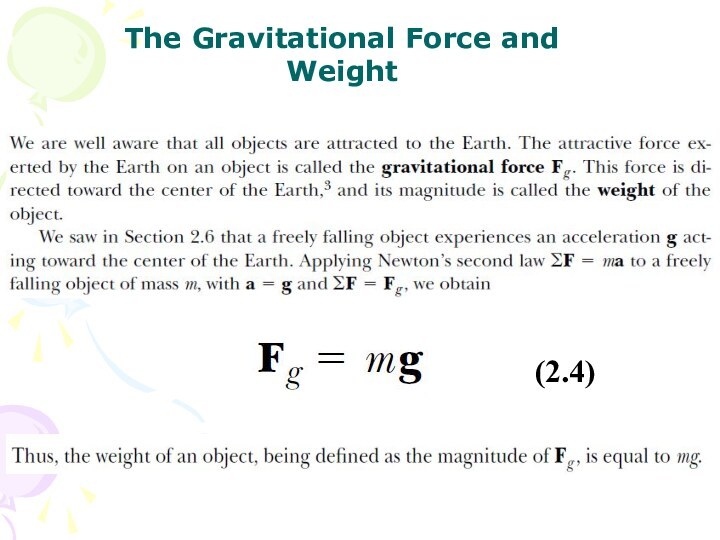

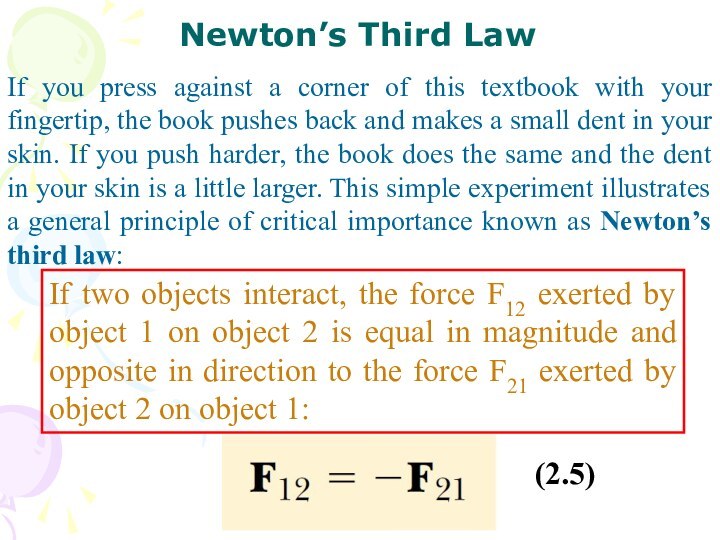










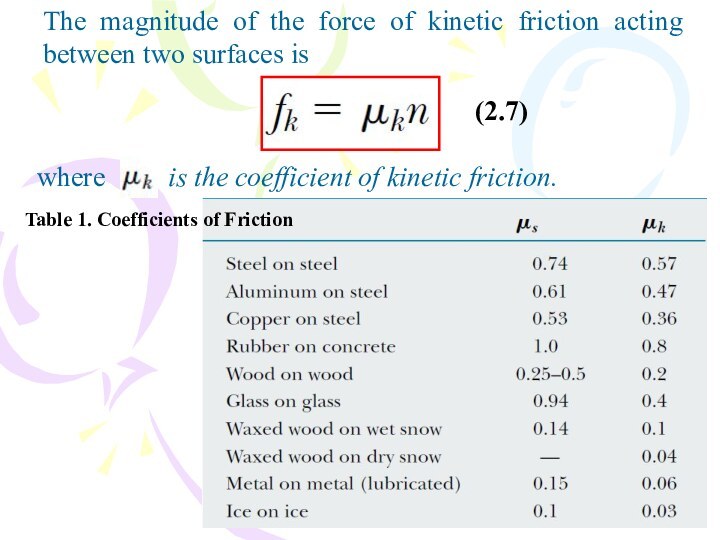







Слайд 3 Previously we described motion in terms of position,
velocity, and acceleration without considering what might cause that
motion. Now we consider the cause—what might cause one object to remain at rest and another object to accelerate? The two main factors we need to consider are the forces acting on an object and the mass of the object. We discuss the three basic laws of motion, which deal with forces and masses and were formulated more than three centuries ago by Isaac Newton. Once we understand these laws, we can answer such questions as “What mechanism changes motion?” and “Why do some objects accelerate more than others?”
Слайд 5
The Concept of Force
The only known fundamental forces
in nature are all field forces:
gravitational forces between
objects,electromagnetic forces between electric charges,
nuclear forces between subatomic particles, and
weak forces that arise in certain radioactive decay processes.
In classical physics, we are concerned only with gravitational and electromagnetic forces.
Слайд 7 If an object does not interact with other
objects, it is possible to identify a reference
frame in
which the object has zero acceleration.Moving object can be observed from any number of reference frames. Newton’s first law of motion, sometimes called the law of inertia, defines a special set of reference frames called inertial frames. This law can be stated as follows:
Newton’s First Law and Inertial Frames
Слайд 8 Such a reference frame is called an inertial
frame of reference.
Any reference frame that moves with constant
velocity relative to an inertial frame is itself an inertial frame.Newton’s First Law and Inertial Frames
Слайд 9 When no force acts on an object, the
acceleration of the object is zero.
In the absence of
external forces, when viewed from an inertial reference frame, an object at rest remains at rest and an object in motion continues in motion with a constant velocity (that is, with a constant speed in a straight line).Newton’s First Law and Inertial Frames
Слайд 10
Mass
Mass is that property of an object that
specifies how much resistance an object exhibits to changes
in its velocity, and the SI unit of mass is the kilogram. The greater the mass of an object, the less that object accelerates under the action of a given applied force.Слайд 11 To describe mass quantitatively, we begin by experimentally
comparing the accelerations a given force produces on different
objects. Suppose a force acting on an object of mass m1 produces an acceleration a1, and the same force acting on an object of mass m2 produces an acceleration a2. The ratio of the two masses is defined as the inverse ratio of the magnitudes of the accelerations produced by the force:(2.1)
Mass
Слайд 12 Mass is an inherent property of an object
and is independent of the object’s surroundings and of
the method used to measure it.Also, mass is a scalar quantity and thus obeys the rules of ordinary arithmetic. That is, several masses can be combined in simple numerical fashion. For example, if you combine a 3-kg mass with a 5-kg mass, the total mass is 8 kg. We can verify this result experimentally by comparing the accelerations that a known force gives to several objects separately with the acceleration that the same force gives to the same objects combined as one unit.
Mass
Слайд 13 Mass should not be confused with weight. Mass
and weight are two different quantities. The weight of
an object is equal to the magnitude of the gravitational force exerted on the object and varies with location. For example, a person who weighs 180 lb on the Earth weighs only about 30 lb on the Moon. On the other hand, the mass of an object is the same everywhere: an object having a mass of 2 kg on the Earth also has a mass of 2 kg on the Moon.Mass
Слайд 14 Newton’s first law explains what happens to an
object when no forces act on it. It either
remains at rest or moves in a straight line with constant speed. Newton’s second law answers the question of what happens to an object that has a nonzero resultant force acting on it.Newton’s Second Law
Слайд 15 Imagine performing an experiment in which you push
a block of ice across a frictionless horizontal surface.
When you exert some horizontal force F on the block, it moves with some acceleration a. If you apply a force twice as great, you find that the acceleration of the block doubles. If you increase the applied force to 3F, the acceleration triples, and so on. From such observations, we conclude that the acceleration of an object is directly proportional to the force acting on it.Newton’s Second Law
Слайд 16 The acceleration of an object also depends on
its mass, as stated in the preceding section. We
can understand this by considering the following experiment. If you apply a force F to a block of ice on a frictionless surface, the block undergoes some acceleration a. If the mass of the block is doubled, the same applied force produces an acceleration a/2. If the mass is tripled, the same applied force produces an acceleration a/3, and so on.Newton’s Second Law
Слайд 17 According to this observation, we conclude that the
magnitude of the acceleration of an object is inversely
proportional to its mass. These observations are summarized in Newton’s second law:When viewed from an inertial reference frame, the acceleration of an object is directly proportional to the net force acting on it and inversely proportional to its mass.
Newton’s Second Law
Слайд 18 Thus, we can relate mass, acceleration, and force
through the following mathematical statement of Newton’s second law:
(2.2)
In
both the textual and mathematical statements of Newton’s second law above, we have indicated that the acceleration is due to the net force acting on an object. The net force on an object is the vector sum of all forces acting on the object. In solving a problem using Newton’s second law, it is imperative to determine the correct net force on an object. There may be many forces acting on an object, but there is only one acceleration.Newton’s Second Law
Слайд 19 The SI unit of force is the newton,
which is defined as the force that, when acting
on an object of mass 1 kg, produces an acceleration of 1 m/s2. From this definition and Newton’s second law, we see that the newton can be expressed in terms of the following fundamental units of mass, length, and time:(2.3)
Unit of Force
Слайд 22 If you press against a corner of this
textbook with your fingertip, the book pushes back and
makes a small dent in your skin. If you push harder, the book does the same and the dent in your skin is a little larger. This simple experiment illustrates a general principle of critical importance known as Newton’s third law:If two objects interact, the force F12 exerted by object 1 on object 2 is equal in magnitude and opposite in direction to the force F21 exerted by object 2 on object 1:
(2.5)
Newton’s Third Law
Слайд 23 Forces always occur in pairs, or that a
single isolated force cannot exist. The force that object
1 exerts on object 2 may be called the action force and the force of object 2 on object 1 the reaction force. In reality, either force can be labeled the action or reaction force.Newton’s Third Law
The action force is equal in magnitude to the reaction force and opposite in direction. In all cases, the action and reaction forces act on different objects and must be of the same type.
Слайд 25
Newton’s Third Law
When we apply Newton’s laws to
an object, we are interested only in external forces
that act on the object.For now, we also neglect the effects of friction in those problems involving motion; this is equivalent to stating that the surfaces are frictionless.
In problem statements, the synonymous terms light and of negligible mass are used to indicate that a mass is to be ignored when you work the problems. When a rope attached to an object is pulling on the object, the rope exerts a force T on the object, and the magnitude T of that force is called the tension in the rope. Because it is the magnitude of a vector quantity, tension is a scalar quantity.
Слайд 26
Newton’s Third Law
Objects in Equilibrium
If the acceleration of
an object that can be modeled as a particle
is zero, the particle is in equilibrium.Слайд 28 Actions of bodies to each other, making the
accelerations, called forces. All forces can be divided to
2 main types: forces, acting at the direct contact, and forces, acting independently whether bodies contact or not, i.e. forces, which can act on the distance.Compressions, tensions, flexions etc. are the form or volume change in compare to its initial state. Such changes are called deformations.
Forces, disappearing with disappearing of deformations, called elastic forces.
Forces of Friction
Слайд 29 Except elastic forces at the direct contact can
appear forces of another type so called forces of
friction.The main feature of forces of friction is that they prevent the movement of every of contact bodies respectively to another one or prevent appearing of this movement.
Forces of Friction
Слайд 30 The force that counteracts F and keeps the
trash can from moving acts to the left and
is called the force of static friction fs. As long as the trash can is not moving, fs = F.Fig. 1 – Example of force of friction
Forces of Friction
Слайд 31 The magnitude of the force of static friction
between any two surfaces in contact can have the
valueswhere the dimensionless constant is called the coefficient of static friction and n is the magnitude of the normal force exerted by one surface on the other.
At the same time with changing of direction of force F the direction of force of friction also changes. Thus module and direction of force of friction are defined by module and direction of that external force, which it balanced: force of static friction equals on module and opposite to direction of that external force, which approaches to cause the slipping of one body on another one.
(2.6)
Forces of Friction
Слайд 32 We call the friction force for an object
in motion the force of kinetic friction fk .
Fig. 1 – Example of force of friction
Forces of Friction
Слайд 33 The magnitude of the force of kinetic friction
acting between two surfaces is
where
is the coefficient of kinetic friction.(2.7)
Table 1. Coefficients of Friction
Слайд 34 A particle moving with uniform speed v in
a circular path of radius r experiences an acceleration
that has a magnitude:The acceleration is called centripetal acceleration because ac is directed toward the center of the circle. Furthermore, ac is always perpendicular to v.
Newton’s Second Law Applied
to Uniform Circular Motion
Слайд 35 Figure 2. Overhead view of a ball moving
in a circular path in a horizontal plane. A
force Fr directed toward the center of the circle keeps the ball moving in its circular path.If we apply Newton’s second law along the radial direction, we find that the net force causing the centripetal acceleration can be evaluated:
(2.8)
Слайд 36 If a particle moves with varying speed in
a circular path, there is, in addition to the
radial component of acceleration, a tangential component having magnitude dv/dt. Therefore, the force acting on the particle must also have a tangential and a radial component. Because the total acceleration isthe total force exerted on the particle is
The vector is directed toward the center of the circle and is responsible for the centripetal acceleration. The vector ttt tangent to the circle is responsible for the tangential acceleration, which represents a change in the speed of the particle with time.
(2.9)
Nonuniform Circular Motion










